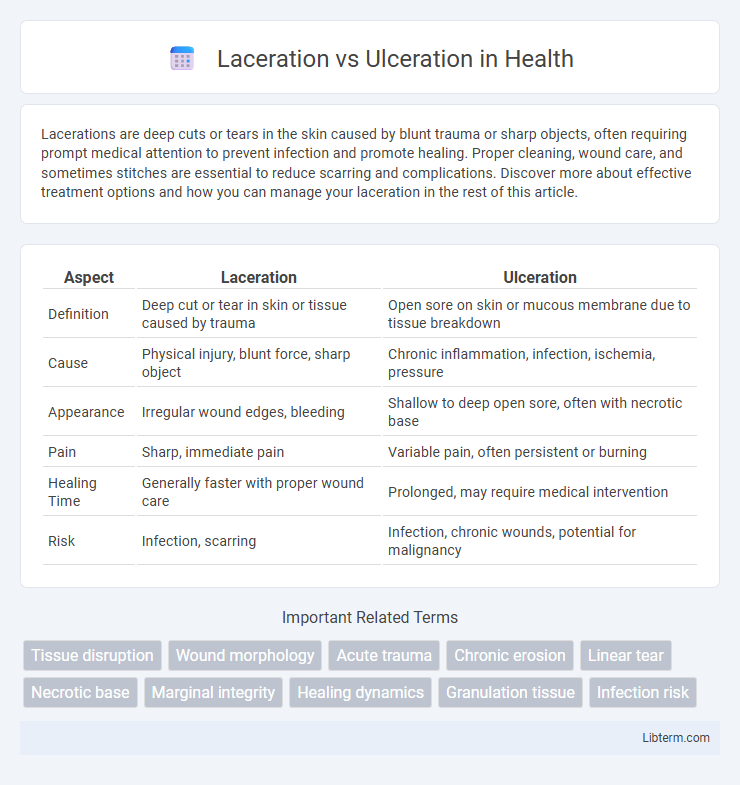Lacerations are deep cuts or tears in the skin caused by blunt trauma or sharp objects, often requiring prompt medical attention to prevent infection and promote healing. Proper cleaning, wound care, and sometimes stitches are essential to reduce scarring and complications. Discover more about effective treatment options and how you can manage your laceration in the rest of this article.
Table of Comparison
| Aspect | Laceration | Ulceration |
|---|---|---|
| Definition | Deep cut or tear in skin or tissue caused by trauma | Open sore on skin or mucous membrane due to tissue breakdown |
| Cause | Physical injury, blunt force, sharp object | Chronic inflammation, infection, ischemia, pressure |
| Appearance | Irregular wound edges, bleeding | Shallow to deep open sore, often with necrotic base |
| Pain | Sharp, immediate pain | Variable pain, often persistent or burning |
| Healing Time | Generally faster with proper wound care | Prolonged, may require medical intervention |
| Risk | Infection, scarring | Infection, chronic wounds, potential for malignancy |
Understanding Laceration and Ulceration
Lacerations are deep cuts or tears in the skin or flesh caused by trauma, often resulting in irregular wound edges and bleeding. Ulcerations refer to open sores on the skin or mucous membranes, typically caused by chronic conditions like infections, pressure, or poor circulation, leading to tissue breakdown and delayed healing. Differentiating between laceration and ulceration is essential for accurate diagnosis and appropriate treatment strategies.
Definition of Laceration
A laceration is a deep cut or tear in the skin or underlying tissues, often caused by blunt trauma or sharp objects, resulting in irregular wound edges. Unlike ulceration, which involves the gradual breakdown of skin or mucous membranes due to sustained pressure, infection, or inflammation, lacerations are typically acute injuries requiring immediate wound care to promote healing and prevent infection. Proper identification of lacerations is crucial in medical settings to determine the need for sutures or surgical intervention.
Definition of Ulceration
Ulceration refers to the pathological process characterized by the loss of the skin or mucosal surface, resulting in an open sore that fails to heal properly. It often arises from factors such as infection, inflammation, ischemia, or trauma, leading to tissue necrosis and prolonged wound presence. Unlike lacerations, which are tears caused by sharp objects or blunt force trauma, ulcerations develop gradually due to underlying disease processes and chronic irritation.
Key Differences Between Laceration and Ulceration
Lacerations are traumatic wounds characterized by irregular, jagged edges caused by blunt force or injury, typically resulting in bleeding and potential tissue damage. Ulcerations are localized open sores on the skin or mucous membranes, often due to prolonged pressure, infection, or vascular insufficiency, leading to tissue necrosis. Key differences include etiology, with lacerations caused by mechanical trauma and ulcerations by chronic pathological processes, and appearance, where lacerations have jagged edges while ulcers present as well-defined open lesions.
Causes of Laceration
Lacerations result from traumatic incidents that cause a deep cut or tear in the skin, often due to blunt force or sharp objects such as knives, glass, or machinery. Unlike ulcerations, which typically develop from chronic conditions like poor blood circulation, infections, or prolonged pressure, lacerations are primarily caused by external physical injuries. Immediate medical attention is crucial to prevent infection and promote proper healing of lacerations.
Causes of Ulceration
Ulceration primarily results from prolonged tissue ischemia, infection, or chronic inflammation leading to the breakdown of the skin or mucous membrane. Common causes include pressure sores, diabetic foot ulcers, venous insufficiency, and autoimmune conditions such as vasculitis. Unlike lacerations, which are acute traumatic wounds caused by sharp objects or blunt force, ulcerations develop gradually due to underlying pathological processes compromising tissue integrity.
Clinical Presentation and Symptoms
Lacerations present as irregular, open wounds with jagged edges often caused by trauma, accompanied by bleeding, pain, and swelling at the injury site. Ulcerations appear as well-defined, shallow or deep sores resulting from tissue breakdown due to ischemia, infection, or chronic pressure, characterized by persistent pain, redness, and sometimes discharge or odor. Differentiating between the two involves assessing wound morphology, cause, and associated systemic symptoms such as fever or delayed healing.
Diagnosis: Laceration vs Ulceration
Diagnosis of lacerations involves identifying irregular, jagged wounds typically caused by trauma, with bleeding and tissue disruption evident upon examination. Ulceration diagnosis requires noting a loss of the epithelial layer, often accompanied by inflammation, necrosis, or infection, primarily detected through visual inspection and sometimes biopsy. Imaging and clinical history aid in distinguishing acute lacerations from chronic ulcerations, which may indicate underlying systemic conditions like diabetes or vascular disease.
Treatment Approaches for Each Condition
Treatment approaches for lacerations prioritize wound cleaning, suturing if necessary, and applying antibiotic ointments to prevent infection and promote healing. Ulceration management involves addressing the underlying cause, such as pressure relief for pressure ulcers or infection control with topical or systemic antibiotics, and advanced dressings to maintain a moist wound environment. Both conditions require careful monitoring for signs of infection and may necessitate pain management tailored to the severity and location of the wound.
Prevention and Long-term Management
Effective prevention of lacerations focuses on protective measures such as wearing appropriate safety gear and maintaining environmental safety to minimize injury risk. Ulceration prevention emphasizes controlling underlying conditions like diabetes and pressure, alongside maintaining proper nutrition and skin hygiene. Long-term management of lacerations involves timely wound cleaning and closure, whereas chronic ulcerations require ongoing wound care, infection control, and addressing systemic factors to promote healing and prevent recurrence.
Laceration Infographic

 libterm.com
libterm.com